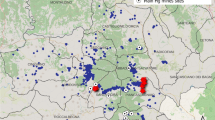Abstract
Occupational exposure to Hg vapour was investigated in 78 workers during three periods with different temperatures: August 1991, December 1991, and February 1992. Each individual was sampled twice in each period; before and after a six working days period (with a two free days interval). As an attempt to normalise Hg excretion urine was sampled always after a normal 8 hours night sleeping and immediately frozen. Mineralisation was done with acid and oxidant mixture and determination by cold vapour Atomic Absorption Spectrophotometry (Varian VGA-76 and AA-1475). Analytical accuracy was controlled by routine analysis of certified reference material (Seronorm TM trace elements, Nycome As diagnostics Olso — Norway) and all samples were analysed in triplicates. Of a total of 355 samples analysed 13% were over the maximum limit for occupational exposure (50 μg.l−1 or ppb). From the 78 individuals investigated 13% presented average value smaller than 10 ppb; just 8% had the average over 50 ppb; 64% showed averages smaller than 30 ppb; and 28% were between 30 and 50 ppb. Seasonal variation was observed with the highest values in the hottest periods. High variability was observed in the same individual even within an interval of just few days (seven days). No increase of Hg in urine after the six days of exposure was observed when compared with the values after the two free days interval.
Similar content being viewed by others
References
Andren, A.W. e Nriagu, J.O. 1979. The global cycle of mercury. In: The biogeochemistry of mercury in the environment. Nriagu, J.O. (Ed.) Amsterdam: Elsevier/North Holland Biomedical Press,. 696 p. p. 1–15.
Barregård, L. 1993. Biological monitoring of exposure to mercury vapour. Scand. J. Work Environ. Health. 19 suppl 1:45–9.
World Health Organization (WHO). 1991. Environmental Health Criteria, 118. Inorganic Mercury-. Geneva, 168 p.
Sällsten, G., Barregård, L and Schütz, A. 1993. Decrease in mercury concentration in blood after long term exposure: a kinetic study of chloralkali workers. British Journal of Industrial Medicine. 50: 814–821.
Minoia, C., Sabbioni, E., Apostoli, P. et al. 1990. Trace element reference values in tissues from inhabitants of the european community. I. A study of 46 elements in urine, blood and serum of italian subjects. The Science of the Total Environment, v. 95, p. 89–105,
Nriagu, J. O. (Ed.). 1979. Production and uses of mercury. In:The biogeochemistry of mercury in the environment. Amsterdam: Elsevier/North Holland Biomedical Press, 696 p. p. pp23–39.
Author information
Authors and Affiliations
Rights and permissions
About this article
Cite this article
Malm, O., Calasans, C.F., Fernandes, A.P. et al. Exposure to metallic mercury in workers in a tropical chloralkali plant evaluated through urine analysis, Rio de Janeiro, Brazil. Water Air Soil Pollut 97, 185–191 (1997). https://doi.org/10.1007/BF02409654
Issue Date:
DOI: https://doi.org/10.1007/BF02409654




